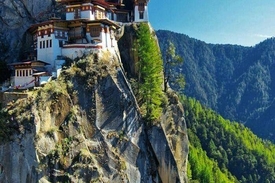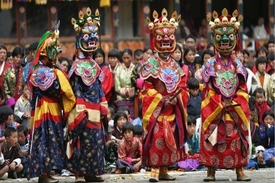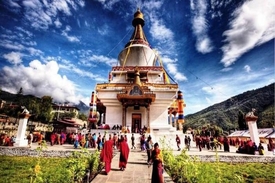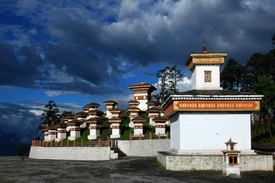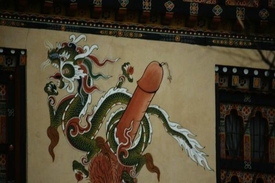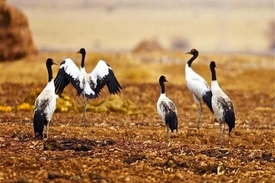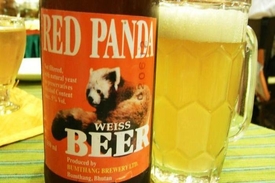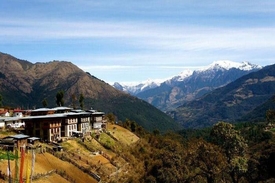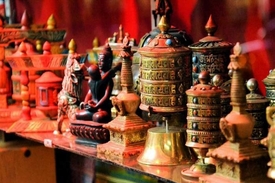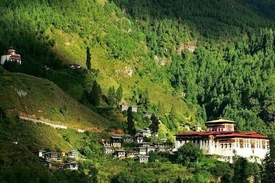This tour is just perfect for incentive tours looking to experience the best of Bhutan, which measures development, and progress in terms of Gross National Happiness as opposed to the conventional Gross Domestic Product.
Enjoy the unspoilt, distinctive culture and tradition among the hospitable people, magnificent Dzongs (fortress-like structures), serene monasteries, charming villages and amazing mountain landscapes in the peaceful Himalayan Buddhist Kingdom.
Day 01 Arrive Paro
The flight to Paro Bhutan airport is one of the most spectacular mountain flights in the world, a constantly changing panorama of the some of the highest mountains on the earth.
The charming town of Paro lies on the banks of the Paro (or Pa) Chhu, just a short distance northwest of the imposing Paro Dzong. The main street, only built in 1985, is lined with colourfully painted wooden shop fronts and restaurants, though these appear under threat as the town grows and multi-storey concrete buildings continue to propagate. For now Paro remains one of the best Bhutanese towns to explore on foot and is worth an hour or two’s stroll at the end of a day of sightseeing.
We will be checking into the hotel that combines the culture, heritage and architecture of Bhutan, with 21st century comfort and technology.
In the afternoon, we can visit some of the iconic sites of Paro.
• Paro Rinpung Dzong – The Paro Dzong is one of Bhutan’s most impressive and well-known dzongs, and perhaps the finest example of Bhutanese architecture you’ll see. The massive buttressed walls that tower over the town are visible throughout the valley.The dzong’s correct name, Rinchen Pung Dzong (usually shortened to Rinpung Dzong), means ‘fortress on a heap of jewels’. In 1644 Zhabdrung Ngawang Namgyal ordered the construction of the dzong on the foundation of a monastery built by Guru Rinpoche.
• Paro Weekend Market – Paro’s weekend market isn’t very large but it has a traditional feel and is a fine introduction to some of Bhutan’s unique local products, from organic Tsirang honey to the squares of dried jellied cow skin known as khoo (a local snack). The market is busiest on Sunday mornings but the vegetable stalls remain throughout the week.
As you wander the stalls, look for strings of chugo (dried yak cheese), either white (boiled in milk and dried in the sun) or brown (smoked). The fruit that looks like an orange egg is actually fresh husky betel nut, imported from India. The jars of pink paste contain lime, which is ingested with the betel nut. There are also exotic-looking ferns, powdered juniper incense, and patties of datse, the cheese used in almost every Bhutanese dish.
• Kyichu Lhakhang – A short drive from Paro is Kyichu Lhakhang, one of Bhutan’s oldest and most beautiful temples. The temple is popularly believed to have been built in 659 by King Songtsen Gampo of Tibet, to pin down the left foot of a giant ogress who was thwarting the establishment of Buddhism into Tibet. Additional buildings and a golden roof were constructed in 1839 by the penlop (governor) of Paro and the 25th Je Khenpo. Elderly pilgrims constantly walk around the temple spinning its many prayer wheels.
Day 02 Paro – Thimpu (By Road) (55 Kms. / 1 hr. appx.)
Drive to the capital city of Bhutan, Thimphu is a unique city with unusual mixture of modern development alongside ancient traditions. Although not what one expects from a capital city, Thimphu is still a fitting and lively place.
In the afternoon, visit the following sights:
• National memorial stupa – This stupa was built in 1974 in the memory of Bhutan’s third King, His Late Majesty, King Jigme Dorji Wangchuk, who is popularly regarded as Father of modern Bhutan. The paintings and statues inside the monument provide a deep insight into Buddhist philosophy.
• Institute for the 13 arts and craft (Zorig Chu-sum) – Commonly known as Arts & Crafts School or Painting School, the Institute offers a six-year course on the 13 traditional arts and crafts of Bhutan. On a visit, one can see students learning the various skills taught at the school.
• Weekend market – Every Thursday to Sunday most of Thimphu’s scant population and many valley dwellers congregate on the banks of the river where weekend market is held. It is an interesting place to visit and provides opportunity to mingle with the local people.
Day 03 Thimphu – Punakha (By Road) (85 Kms. / 2.5 hrs. appx.)
After breakfast, drive to Punakha.
After checking in at the hotel in Punakha, guest can visit the following sights in the afternoon:
• Punakha Dzong – Built strategically at the junction of Pho Chhu and Mo Chhu rivers in 1637, by Shabdrung Ngawang Namgyal to serve as the religious and administrative center of the region, Punakha Dzong has played an important role in Bhutan’s history. The Dzong is open for visitors during Punakha festival and in summer months when the monk body moves to Thimphu.
• Chimi lhakhang (Fertility temple) – The Chimi Lhakhang, situated on a hillock in the centre of the valley, is dedicated to Lama Drukpa Kuenley, who in the late 15th century used humor, songs and outrageous behavior to dramatize his teachings and due to this also known as “Divine Madman”. This temple is also known as the temple of fertility. It is widely believed that couples who do not have children and wanting one, if they pray at this temple, they are usually blessed with a child very soon.
Overnight in Punakha.
Day 04 Punakha – Gantey (By Road) (75 Kms. / 2 hrs. appx.)
We begin the day with breakfast, before heading down to Mo Chhu, one of the many beautiful, pristine river of Bhutan, for White Water Rafting. Mo Chhu begins high in the Northern Himalayas, and run downwards, converging with Pho Chhu at Punakha Dzong. With a series of easy Class 2 and 3 rapids, Mo Chhu is the most rafted river in Bhutan. Enjoy the breath-taking views of Punakha, while being surrounded by clear blue water, and with the Himalayas as the backdrop, while you float through a beautiful canyon. If you are lucky, you might even have a chance to spot one of the world’s rarest bird – Black Necked Cranes.
The entire river is about 16km long, and will take about 2-3 hours to complete. In the afternoon, after resting at the hotel, from the white water rafting, you will be transported back to Paro on a 4 hour trip. After checking in, you will be able to rest, or do some last minute shopping or visiting.
Later, drive to Gantey.
You can experience the Bhutanese Traditional herbal hot stone bath. “Bhutan is historically known as Lhomen Menjong – The land of the medicinal herbs. Hot-stone-bath is a very popular form of medication practiced in Bhutan. There is no recorded history of its origin. In the olden times it was a luxury enjoyed by the well to do families. A whole day was spent to organize this particular event where the whole family would take part in the hot-stone bathing ceremony”.
Visiting Gangtey Goempa (alt. 3000m/9845ft) is also a great option! Perched on a small hill that rises from the valley floor, the Gangtey Monastery is the only Nyingmapa monastery on the western side of the Black Mountain’s Gangtey valley, Bhutan and also the biggest Nyingmapa monastery in Bhutan.
Phobjikha is one of Bhutan’s few glacial valleys, and chosen winter home of black necked cranes (November – March) migrating from the Tibetan plateau. The valley is one of the most beautiful valleys in Bhutan and hike towards the beautiful Phobjikha valley.
Overnight in Gantey.
Day 05 Gantey – Bumthang (By Road) (157 Kms. / 4 hrs. appx.)
A pleasurable walk in the morning (around 2 hours) that gives a nice feeling for Phobjikha Valley. It is the most beautiful and shortest of the existing nature trails in Bhutan. From the small hilltop overlooking Gangtey Goemba, head downhill through flower meadows to Semchubara village and from here through beautiful forests and into the open valley. After passing a chorten and Khewa Lhakhang, the trail ends at the local community school; this involves a 30 minute walk up to the start of town. The Nature Trail can be combined with a visit to Gangtey Goemba and the local school.
Gangtey Goemba is a 16th century monastery situated picturesquely at the hilltop at the edge of Gangtey village, making it the landmark structure of Phobjikha valley.
Later, drive to Bumthang.
Overnight in Bumthang.
Day 06 Bumthang
Today, we will be visiting Bumthang, also known as the Valley of Beautiful Girls.
Bumthang (alt. 2600m-4500m / 8530ft-14765ft): Comprising of four smaller valleys namely Tang, Ura, Choekhor and Chumey, the deeply spiritual region of Bumthang is shrouded in religious legend. Bumthang is also the traditional home to the great Buddhist teacher Pema Linga to whose descendants the present dynasty traces its origin.
• Jakar Dzong – Founded by great grand-father of the first Shabdrung, the Dzong was initially built as a monastery in 1549. It was upgraded after the Shabdrung had firmly established his power in 1646. The Dzong is now used as administrative centre for Bumthang valley, and houses the regional monk body.
• Konchogsum Lhakhang – It was built in the 6th century but was renovated in 1995, which accounts for its fresh look. It contained a large bell and it is said that when this bell was rung it could be heard all the way in Lhasa in Tibet. During the 17th century a Tibetan Army tried to steal this bell but was too heavy and they dropped it and cracked it. It is now displayed at the National Museum in Paro.
• Chankhar Lhakhang – Beyond Jambay Lhakhang is Changkhar Lhakhang, the site of the palace of the Indian King Sindhu Raja. Because of its simplicity it looks like an ordinary village house. The original palace was built of iron and this is why it was named Chankhar, meaning iron castle. It was rebuilt in the 14th century by a Saint called- Dorji Lingpa.
• Lhodrak Kharchhu Monastery – Located above the main town, about 3 km from Chamkhar town, the monastery was founded by Namkhai Nyingpo Rinpoche in 1984 who was recognized at a very young age by H.H. the 14th Dalai Lama and H.H. 16th Karmapa as the reincarnation of a Tibetan lama whose spiritual lineage dates back to the nearest disciples of the great 9th century master.
Overnight in Bumthang.
Day 07 Bumthang – Paro (By Flight)
After breakfast, transfer to airport for flight to Paro.
On arrival, meet assist and enjoy’s Paro wide array of services, which includes:
• Joining the monks at the Meditation House
• Soak up the tranquility of the Tea House
• Enjoy a unique selection of spa treatments imbued with spiritual symbolism
• Unwinding with a drink at the Mad Monk Ba
PLACES OF INTEREST:
• Paro Rinpung Dzong – Rinpung Dzong, also known as “fortress of the heap of jewels “, was built in 1646 by Zhangdrung Rinpochhe. It now houses as administrative and religious centre of Paro Dzongkhag. The approach to the Dzong is through a traditional covered bridge called the Nemi Zam which offers a good view of the architectural wonder of the Dzong as well as life around it.
• Drukgyel Dzong – Drugyal Dzong which means victorious fortress was built in 1646 by Shabdrung to honor his victory over the Tibetan invaders, led by the Mongolian warlord, Gushri Khan in 1644. It was strategically built over the only passage into Paro valley. The glory of Drukgyel Dzong remained even when it was destroyed by fire in 1951.
• Ta Dzong – Ta Dzong (watch tower) built in 1951 to defend Rinpung Dzong during inter-valley wars of the 17th century. It was re-established as the National Museum in 1967 and was rated among the best natural history museums in Asia. It holds mesmerizing collection of art, relics, religious thangkha paintings and Bhutan’s exquisite postage stamps etc. 4. Kyichu Monastery: Kyichu temple is one of the most holy and oldest temples in Bhutan. It was built in 7th Century by the Tibetan King Songtsen Gampo, to subdue the demons that were petrifying the Himalayan countries.
Overnight in Paro.
Day 08 Depart Paro
After breakfast, departure tranfer to Paro International Airport for flight to onward destination.
| City | Night (s) | 3* Hotels | 4* Hotels | 5* Hotels |
| Paro | 01 | Metta Resort | Naksel Boutique | Le Meridien |
| Thimphu | 01 | Norbuling Hotel | Druk Thimphu | Le Meridien |
| Punakha | 01 | Kingaling Hotel | Himalayan Dragon’s Nest | COMO Uma Punakha |
| Gangtey | 01 | Gangtey Lodge | Dewachen Hotel | Amankora Gangtey |
| Bumthang | 02 | The Village Lodge | Yangkhill Resort | Amankora Bumthang |
| Paro | 01 | Metta Resort | Naksel Boutique | Le Meridien |
Inclusions
– Welcome with fresh flower garlands.
– Meet assist at the airport and hotels.
– 07 nights accommodation as per the program in the hotels / resorts / Camps of your choice.
– Bhutan Visa Fees.
– Daily breakfast, lunch and dinners.
– Alcohol package during the lunch and dinner every day.
– Welcome Gala Dinner and Farewell Gala Dinner.
– Theme dinners as per your choice.
– Cultural Folk Dance shows with live music.
– All transfers, sightseeing, excursions by private AC vehicle as per the program.
– Accompanying English / German / French / Italian / Spanish / Chinese / Arabic / Korean / Hebrew / Polish / Russian speaking escort cum guide from arrival till departure.
– Entrance fees to the monuments as per the program.
– All taxes.
Activities
– Turban & Saree tying lesson.
– Masala Chai Demonstration.
– Local Cuisine live demonstration.
– Cultural dance show.
– 01 Yoga class.
– 01 dinner of Indian thali.
– Hot Air Balloon Ride.
– Elephant Safari.
– Magic Show.
– Henna Painting.
– Stand-up Comedian.
– Tuk Tuk / Rickshaw Ride.
– Dress in local attire with dinner.
– River Rafting.
– Boat Cruising.
– Hot Stone Bath.
– Astrology & Palm Reading.
– Live Theatre Performance
Branding
– Logo branding on Vehicles.
– Color and logo branding Merchandise.
– Departure gifts with company’s branding.
– Tips.
– International Air Fare.
– Travel & health insurance.
– Personal expenses and drinks.
– Accommodation in good hotels.
– Check-in / out time is 12 noon at most of the hotels.
– Extension to other places is also possible with a minimal extra cost.
– A visa is required and must be obtained prior to your departure from your Country.
– If quoted hotel is not available, we will provide one of a similar category and standard.
– Small deviations in the tour program are sometimes necessary, depending on weather, road conditions, flight schedules and room availability.
– In case the government changes presently applicable taxes, increase in airlines prices, fuel surcharge our rates will need to be adjusted accordingly.
– In Asia, there is no relevance between the distance and time of traveling, as it depends upon the condition of the roads and congestion of the traffic.
– While every effort will be made to maintain the itinerary, in view of local strikes etc that are beyond our control all schedule and itineraries are subject to last moment changes.
– Clients must be fully insured, as the company cannot accept liability for loss or damage to client’s property, medical emergencies or any other loss suffered by them whilst on tour.
– In Case of issuing Domestic or International air tickets, SGV is not responsible for any refund if the flight is delayed or cancelled, as it is the responsibility of airline.



